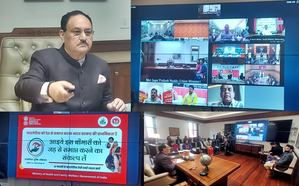BILKULONLINE
Gandhinagar, Feb 10 : In a step towards eradicating Lymphatic Filariasis (commonly known as Elephantiasis), Union Health Minister J.P. Nadda virtually launched the Mass Drug Administration (MDA) program on Monday in the presence of Gujarat Health Minister Rishikesh Patel and senior health officials.
The initiative aligns with the Union government’s target of eliminating Filariasis by 2027 and marks the beginning of the second phase of the campaign, scheduled from February 10 to 12. Under this phase, mass drug distribution will be carried out across four talukas – Netrang in Bharuch district, Nandod and Dediyapada in Narmada district, and Waghai in Dang district, covering an estimated 5.46 lakh people. The program aims to administer preventive medication to halt the spread of Lymphatic Filariasis, a disease transmitted by mosquitoes that can cause severe physical disabilities. Speaking at the launch, Union Minister J.P. Nadda emphasised the government’s commitment to public health, stating, “The eradication of Filariasis is a national priority, and collective participation in mass drug administration will be crucial in achieving our goal by 2027.”
Gujarat Health Minister Rishikesh Patel urged people to actively participate and take the necessary medication. “Historically, in the 1960s, Surat City reported an infection rate of approximately 23 per cent and an infectivity rate of 1.6 per cent. To combat this, the National Filaria Control Programme established a Filaria Control Unit in Surat to detect and treat cases,” he said. In 2004, India launched the Elimination of Lymphatic Filariasis campaign through Mass Drug Administration (MDA) with annual single doses of diethylcarbamazine (DEC) tablets in all LF-endemic districts, including Surat. Between 2004 and 2007, four rounds of MDA resulted in a 41 per cent reduction in microfilaria (mf) rate, with significant decreases in infection and infectivity rates. By 2015, the average mf rate in Gujarat had decreased to 0.44 per cent, indicating substantial progress toward elimination. Post-MDA surveys showed drug coverage between 81 per cent and 88 per cent, with epidemiological coverage ranging from 77 per cent to 89 per cent. Directly observed consumption improved from 58 per cent in 2010 to 82 per cent in 2015, and knowledge about the benefits of the drug increased from 59 per cent to 90 per cent over the same period.
